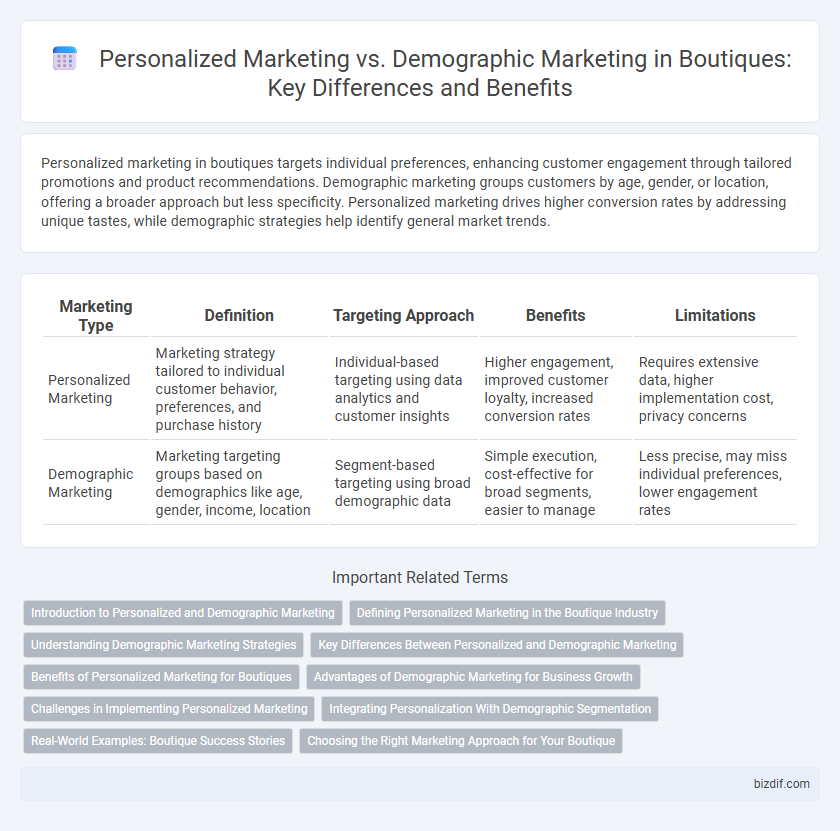Personalized marketing in boutiques targets individual preferences, enhancing customer engagement through tailored promotions and product recommendations. Demographic marketing groups customers by age, gender, or location, offering a broader approach but less specificity. Personalized marketing drives higher conversion rates by addressing unique tastes, while demographic strategies help identify general market trends.
Table of Comparison
| Marketing Type | Definition | Targeting Approach | Benefits | Limitations |
|---|---|---|---|---|
| Personalized Marketing | Marketing strategy tailored to individual customer behavior, preferences, and purchase history | Individual-based targeting using data analytics and customer insights | Higher engagement, improved customer loyalty, increased conversion rates | Requires extensive data, higher implementation cost, privacy concerns |
| Demographic Marketing | Marketing targeting groups based on demographics like age, gender, income, location | Segment-based targeting using broad demographic data | Simple execution, cost-effective for broad segments, easier to manage | Less precise, may miss individual preferences, lower engagement rates |
Introduction to Personalized and Demographic Marketing
Personalized marketing targets individual customer preferences using data insights, enhancing engagement and conversion rates for boutique businesses. Demographic marketing segments audiences based on characteristics like age, gender, and location, offering broader but less tailored messaging. Understanding the distinction allows boutiques to optimize campaigns, combining personalized approaches for higher relevance with demographic strategies for market reach.
Defining Personalized Marketing in the Boutique Industry
Personalized marketing in the boutique industry centers on tailoring offers, communications, and experiences to individual customer preferences, behaviors, and purchase history, rather than broad age or gender categories. By leveraging data analytics and customer insights, boutiques create unique shopping journeys that enhance engagement and loyalty. This approach contrasts with demographic marketing, which targets groups based on generalized traits, often missing the nuances that drive boutique consumer behavior.
Understanding Demographic Marketing Strategies
Demographic marketing strategies in boutiques segment customers based on age, gender, income, and location to tailor product offerings and promotions effectively. This approach enables targeted messaging that aligns with specific group preferences, enhancing customer engagement and sales conversion. Understanding key demographic data allows boutiques to optimize inventory and marketing budgets for maximum return on investment.
Key Differences Between Personalized and Demographic Marketing
Personalized marketing tailors content and offers based on individual customer behavior, preferences, and purchase history, creating highly targeted campaigns for increased engagement. Demographic marketing segments audiences by broader categories such as age, gender, location, or income, providing generalized messaging to a wider group. The key difference lies in the level of specificity, with personalized marketing delivering unique experiences while demographic marketing relies on statistical group characteristics.
Benefits of Personalized Marketing for Boutiques
Personalized marketing empowers boutiques to tailor product recommendations and promotions based on individual customer preferences, enhancing customer engagement and satisfaction. This approach increases conversion rates by delivering relevant content that resonates on a personal level, fostering loyalty and repeat business. By leveraging data analytics and customer behavior insights, boutiques can optimize inventory and marketing strategies, driving higher revenue compared to traditional demographic marketing.
Advantages of Demographic Marketing for Business Growth
Demographic marketing enables boutiques to target specific customer segments based on age, gender, income, and education level, leading to more efficient allocation of advertising resources. This approach enhances customer acquisition by addressing the distinct preferences and purchasing behaviors within defined groups, driving higher conversion rates. Utilizing demographic data also allows businesses to forecast market trends and tailor inventory, thereby supporting sustained business growth and competitive advantage.
Challenges in Implementing Personalized Marketing
Personalized marketing in boutiques faces challenges such as the need for sophisticated data collection tools and advanced analytics to accurately capture individual customer preferences. Maintaining privacy compliance and securing sensitive customer information complicates data management efforts. High implementation costs and the requirement for continuous content customization further hinder the effective deployment of personalized marketing strategies.
Integrating Personalization With Demographic Segmentation
Integrating personalization with demographic segmentation enhances boutique marketing by targeting specific age, gender, and income groups while customizing messages to individual preferences and behaviors. This combination increases customer engagement and conversion rates by delivering relevant offers that resonate personally within defined demographic segments. Using data analytics and AI-driven insights allows boutiques to create dynamic marketing strategies tailored to both broad demographics and unique customer profiles.
Real-World Examples: Boutique Success Stories
Personalized marketing in boutiques leverages customer data to create tailored experiences, as seen in Stitch Fix's use of AI to customize clothing recommendations enhancing customer loyalty. Demographic marketing, such as Madewell targeting millennial women with style preferences and price points, drives broad engagement through age and lifestyle segmentation. Boutique success stories demonstrate that combining personalized insights with demographic strategies maximizes customer retention and sales growth.
Choosing the Right Marketing Approach for Your Boutique
Personalized marketing leverages customer data, preferences, and behaviors to create tailored experiences that resonate deeply with boutique shoppers, enhancing customer loyalty and increasing conversion rates. Demographic marketing segments audiences based on age, gender, income, or location, offering broader targeting but potentially missing nuanced individual preferences. Selecting the right marketing approach involves analyzing boutique customer data and business goals to balance customization and reach, ultimately driving more meaningful engagement and sales.
Personalized Marketing vs Demographic Marketing Infographic

 bizdif.com
bizdif.com